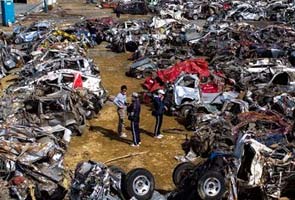
The United States Geological Service said the quake, near the crippled Fukushima Daiichi Nuclear Power Station, had a magnitude of 6.6, and was expected to cause blackouts in the area, government officials said. It was shallower than most of the previous aftershocks -- only eight miles, half the depth of last Thursday's 7.1-magnitude temblor. Shallow earthquakes often do more damage.
An official for the operator of the Fukushima plant, Tokyo Electric Power Company, said a temporary loss of external power at the plant following the aftershock had briefly knocked out pumps sending water into the facility's three most severely damaged reactors.
Elsewhere in Fukushima Prefecture, a landslide engulfed cars with several passengers inside, according to the broadcaster NHK.
Monday's aftershock took place farther south than earlier ones, and was the most powerful recorded between Fukushima and Tokyo. The epicenter of the latest event was 50 miles south of Fukushima and 101 miles north-northeast of Tokyo.
Earlier Monday, thousands bowed their heads in silence to mark the one-month anniversary of the 9.0-magnitude earthquake and ensuing tsunami that brought widespread destruction to a wide swath of Japan's northeast Pacific coast and triggered a nuclear crisis.
In Tokyo, Yukio Edano, the chief cabinet secretary, said that the government would order parts of five villages and cities outside the current zone to prepare to evacuate. These areas are feared to be receiving exposure to radiation equivalent to at least 20 millisieverts a year, he said, which could be harmful to human health over the long term. Evacuation orders will come within a month, Mr. Edano said.
Five other areas may be told to evacuate if there is a worsening of the crisis at the Fukushima Daiichi station, which was severely damaged in the March 11 tsunami, said Mr. Edano.
"This measure is not an order for you to evacuate or take actions immediately," he said. "We arrived at this decision by taking into account the risks of remaining in the area in the long term," he added, appealing for calm.
The Japanese government had so far refused to widen the zone, despite being urged to do so by the International Atomic Energy Agency, and countries such as the United States and Australia advised their citizens to stay 50 miles away from the plant. Mr. Edano said that the chance of a large-scale radiation leak from the Fukushima Daiichi plant had, in fact, decreased.
Michael Friedlander, a former senior nuclear plant operator for 13 years in the United States and a specialist in emergency responses to nuclear accidents, said that the Japanese decision to evacuate a wider area made sense not just in terms of protecting people in these areas, but also in terms of making easier the eventual decontamination of farms and communities.
Allowing people and non-emergency vehicles to continue moving through radiation-contaminated areas and safer areas on the outskirts of the Fukushima Daiichi reactors runs the risk of spreading around radioactively contaminated particles, which could result in more square miles of territory being contaminated. "Unless you gain control, it will be like trying to mop your kitchen floor with the kids running in and out of the house," Mr. Friedlander said.
The I.A.E.A., based in Vienna, said on Sunday that its team had measured radiation on Saturday of 0.4 to 3.7 microsieverts per hour at distances of 20 to 40 miles from the damaged nuclear reactors -- well outside the earlier evacuation zone. At that rate of accumulation, it would take to 225 days to 5.7 years to reach the Japanese government's cutoff of evacuating areas where radiation is accumulating at a rate of at least 20 millisieverts per year.
In other words, only the areas with the highest readings would qualify for the new evacuation ordered by the government.
But the former Soviet Union used a lower cutoff -- 5 millisieverts per year -- in eventually offering resettlement to people near the Chernobyl reactors in 1986. The rates of radiation accumulation identified by the I.A.E.A. would take 56 days to 17 months to reach this level.
At the plant, workers have said they are no closer to restoring vital cooling systems at the plant's six reactors. Though airborne radiation levels around the plant have come down in recent weeks, the plant has been battling to contain leaks of highly radioactive water from the facility.
The plant's operator, Tokyo Electric Power Company, has pumped water into the reactors to cool the nuclear fuel rods, but that has produced harmful runoff of at least 60,000 tons of contaminated water and workers have been forced to pump lower-level radioactive water into the Pacific Ocean.
The news of wider evacuations came exactly a month after the earthquake and tsunami. Across the country at evacuation centers, at work and on the street, people observed a moment of silence at 2:46 p.m. to mark the time of the quake.
"We will not let the tsunami defeat us," the mayor of the coastal city of Miyako, overrun by waves that measured as high as 125 feet, said in a message broadcast across the city through emergency speakers earlier Monday.
In the port city famous for its salmon trade, about 370 miles north of Tokyo, about 400 people have been confirmed dead and 682 remain missing. Almost 3,500 people remain in evacuation centers after losing their homes. "If we keep up our courage and hope," said Mayor Masanori Yamamoto, "Miyako will surely recover."
The death toll from the disaster, Japan's worst since World War II, has surpassed 13,000, with more than 14,000 people still missing, according to Japan's National Police Agency. The figures include the casualties from the March 11 quake and tsunami, as well as the several aftershocks that have since jolted northeast Japan.
Officials have said that many people may never be accounted for, likely washed out to sea or buried under mountains of rubble. More than 150,000 people remain housed in emergency shelters, the national broadcaster NHK said.
No comments:
Post a Comment